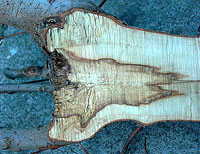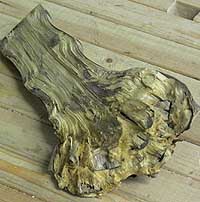Home > Health and maintenance > Risk assessment > Direct injury
Direct injury
 Removing
or damaging above-ground tree parts can result in failure. For example,
squirrels can damage the tops of branches causing the branch to break (see left
photo).
Removing
or damaging above-ground tree parts can result in failure. For example,
squirrels can damage the tops of branches causing the branch to break (see left
photo).
Placing a notch in a palm frond when removing flower stalks or other fronds can cause the damaged frond to collapse some time later. Accidently notching a branch or the trunk with a chain saw while pruning a shade tree can initiate decay and cracks in that branch. This could lead to breakage later.
Lightning
can also cause cracks and other internal damage. Impact from a vehicle can damage
wood fibers in roots and trunk but the tree may remain standing for now only
to fall over later.
Injuring roots can result in massive and sudden tree failure. A tree could remain standing for some time after its roots are cut but can fall over later when a strong wind pushes against it.
 Pruning
history can dramatically influence potential for failure. Trees that were
previously topped can fail when sprouts split from the topping cut some time
later.
Pruning
history can dramatically influence potential for failure. Trees that were
previously topped can fail when sprouts split from the topping cut some time
later.
This results from decay spreading down inside the cut stem (see right photo) or the weak connections that form at the base of sprouts. Trees maintained at the same size using the pollarding technique contain little decay (see left photo). Pollarding cuts trees back to precisely the same point year after year.

